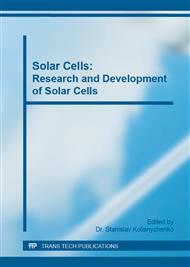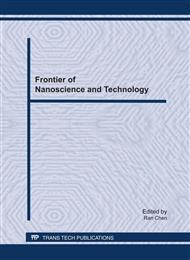p.355
p.360
p.365
p.370
p.375
p.380
p.385
p.391
p.396
The Fabrication and Photoelectric Properties of the Nanopillar Arrays for Solar Cell
Abstract:
a method combining Csesium Chloride (CsCl) self-assembly and inductively coupled plasma (ICP) etching has been used to fabricate nanopillars with high aspect ratio structures on sillicon wafer. The silicon surface with nanopillars of average diameter 350nm and aspect ratios 4, like black wafer, has very low reflectivity at a width of light spectrum. After diffusion of phosphorus (P) and passivation of SiO2 layer on the pillars surface, the reflectivity has been reduced more to below 3% for wavelength from 400nm to 800nm, which could meet the requirement of antireflection for solar cells. What’s more, the reflectivity of nanopillar surface could not obey the formula of reflection to increase with the incident angle of light like planar, and has almost unchanged small values at incident angle of 10°-50°. The solar cell with nanopillars has been fabricated with thermal diffusion of P, chemical deposion of Cu electrode with UV lithography. Its I×V output power of photoelectric property has been measured with sunlight at different time in one day corresponding to different incident angle, and measure of common solar cell is done at the same time for comparation. In order to select the inflection factor of incident angle, the data of output power have been united by dividing max value for nanopillar and common solar cells individually. The united curve of nanopillars cell shows obviously larger value than that of common cell at above incident angle of about 15°, which means nanopillars cell could have the potential ability to offer more electric energy production daily than that of common solar cell.
Info:
Periodical:
Pages:
375-379
Citation:
Online since:
July 2011
Authors:
Keywords:
Price:
Сopyright:
© 2011 Trans Tech Publications Ltd. All Rights Reserved
Share:
Citation:



